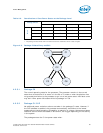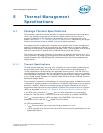
Intel® Xeon® Processor E5-1600/E5-2600/E5-4600 Product Families 101
Datasheet Volume One
Thermal Management Specifications
5 Thermal Management
Specifications
5.1 Package Thermal Specifications
The processor requires a thermal solution to maintain temperatures within operating
limits. Any attempt to operate the processor outside these limits may result in
permanent damage to the processor and potentially other components within the
system, see Section 7.7.1, “Storage Conditions Specifications”. Maintaining the proper
thermal environment is key to reliable, long-term system operation.
A complete solution includes both component and system level thermal management
features. Component level thermal solutions can include active or passive heatsinks
attached to the processor integrated heat spreader (IHS). Typical system level thermal
solutions may consist of system fans combined with ducting and venting.
This section provides data necessary for developing a complete thermal solution. For
more information on designing a component level thermal solution, refer to the
Intel®
Xeon® Processor E5-1600/E5-2600/E5-4600 Product Families Thermal/Mechanical
Design Guide
.
5.1.1 Thermal Specifications
To allow optimal operation and long-term reliability of Intel processor-based systems,
the processor must remain within the minimum and maximum case temperature
(T
CASE
) specifications as defined by the applicable thermal profile. Thermal solutions
not designed to provide sufficient thermal capability may affect the long-term reliability
of the processor and system. For more details on thermal solution design, please refer
to the
Intel® Xeon® Processor E5-1600/E5-2600/E5-4600 Product Families Thermal/
Mechanical Design Guide.
The processors implement a methodology for managing processor temperatures which
is intended to support acoustic noise reduction through fan speed control and to assure
processor reliability. Selection of the appropriate fan speed is based on the relative
temperature data reported by the processor’s Platform Environment Control Interface
(PECI) as described in Section 2.5, “Platform Environment Control Interface (PECI)”.
If the DTS value is less than T
CONTROL
, then the case temperature is permitted to
exceed the Thermal Profile, but the DTS value must remain at or below TCONTROL.
For T
CASE
implementations, if DTS is greater than TCONTROL, then the case
temperature must meet the T
CASE
based Thermal Profiles.
For DTS implementations:
•T
CASE
thermal profile can be ignored during processor run time.
• If DTS is greater than Tcontrol then follow DTS thermal profile specifications for fan
speed optimization.


















